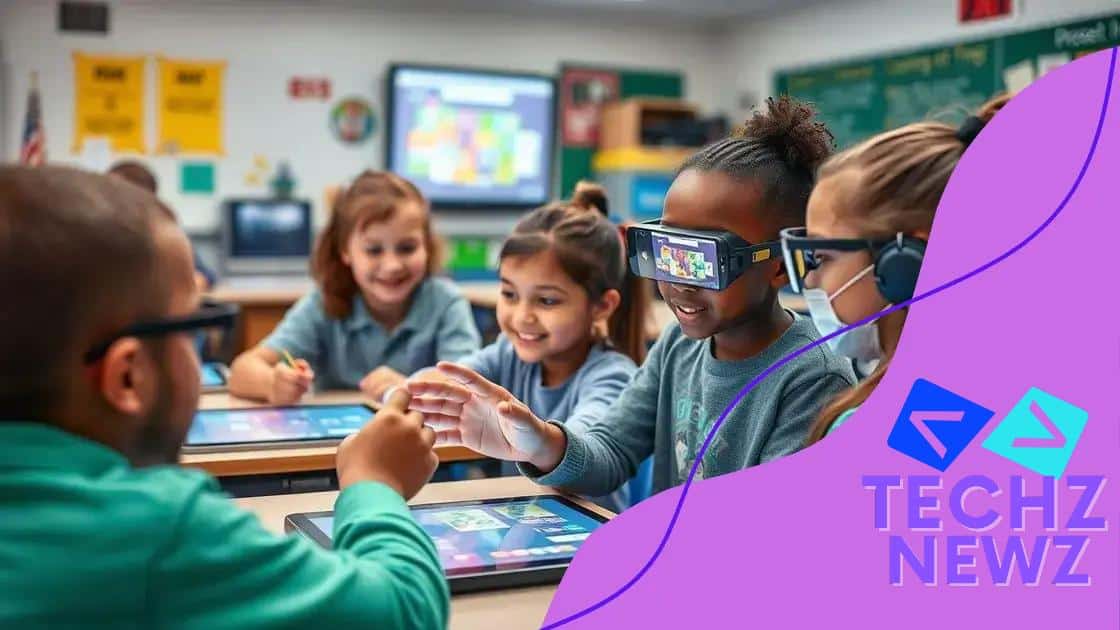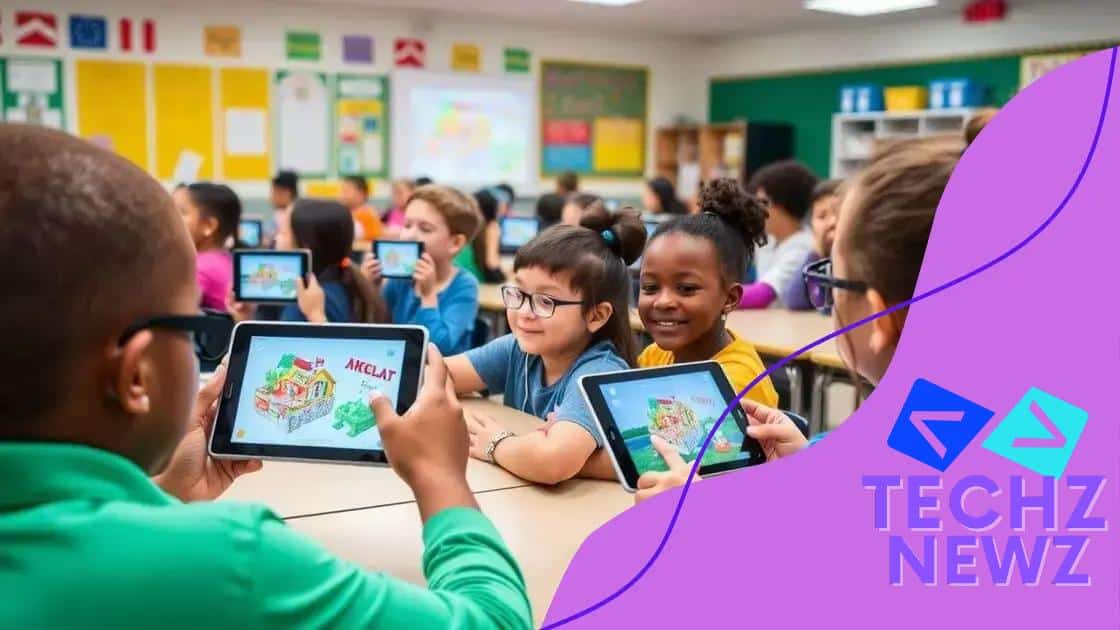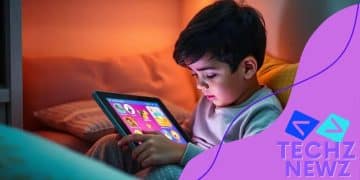How AR is being used for hands-on learning experiences

Augmented Reality (AR) enhances hands-on learning experiences by providing interactive, engaging, and personalized educational opportunities, although its implementation faces challenges like costs and the need for teacher training.
How AR is being used for hands-on learning experiences is changing the way we interact with information. Have you ever imagined stepping into a painting or holding a dinosaur in your living room? With augmented reality, these experiences aren’t just dreams—they’re becoming part of everyday learning.
The basics of augmented reality in education
Augmented Reality, often known as AR, is a technology that overlays digital content onto the real world. In education, it offers a unique way to enhance learning by making lessons interactive and engaging. Imagine studying biology and seeing a 3D model of a heart right in your classroom!
At its core, AR combines the physical and digital worlds. This technology uses devices like smartphones or AR glasses to bring educational content to life. Students can learn through exploration and interaction, which often leads to better retention of information.
How AR Works in Education
AR in education typically relies on applications that allow students to scan objects or images. This triggers digital content, such as videos or 3D models, enhancing the learning experience. For instance, a geography lesson could transform when students can point their device at a globe and see information about different countries popping up.
- Interactive learning experiences
- Self-paced exploration
- Engagement through visuals
- Real-world application of concepts
This innovative approach has made subjects like science and history more accessible. Instead of just reading about ancient civilizations, students can explore reconstructed versions of historical landmarks. They interact with history in a way that reading cannot achieve.
Teachers also benefit from using AR technology because it allows for more personalized teaching methods. Traditional methods may not reach every student, but AR can cater to different learning styles, making lessons more effective. Furthermore, by simplifying complex concepts, AR empowers students to grasp topics they might struggle with otherwise.
Benefits of Integrating AR in Classrooms
Integrating AR into the classroom comes with numerous advantages. Here are a few critical benefits:
- Increased student motivation
- Enhanced collaboration among peers
- Encouragement of critical thinking skills
- Immediate feedback through interactive exercises
As schools continue to adopt new technologies, AR stands out as a revolutionary educational tool. By enriching students’ learning experiences, it bridges the gap between theory and practice. Education is evolving, and AR is helping drive this change.
Benefits of AR for hands-on learning
Embracing Augmented Reality (AR) in education brings numerous benefits that revolutionize hands-on learning. These advantages make lessons more engaging and meaningful for students.
One significant benefit is increased engagement. When students interact with AR tools, their interest spikes. For example, instead of listening to a lecture, they can participate in activities that require them to manipulate virtual objects. This level of involvement enhances their learning experience and makes it more enjoyable.
Key Benefits of AR in Hands-on Learning
- Interactive Experiences: AR allows students to explore concepts they might find challenging in traditional ways. By visualizing subjects, like anatomy or geometry, students gain a better understanding.
- Improved Retention: Studies show that hands-on learning leads to better memory recall. When students experience a lesson through AR, they are more likely to remember the information later.
- Collaboration Opportunities: AR encourages teamwork. Students can work together on projects, sharing ideas while using AR applications. This collaboration fosters communication skills and builds friendships.
- Real-World Applications: With AR, students see how lessons relate to real-world situations, making learning relevant. They can see, for example, how a historical event influenced the present day.
Another advantage is accessibility. AR technology can cater to different learning styles. Visual learners benefit from vivid graphics, while kinesthetic learners engage through interactive content. As a result, AR can make education inclusive for all students.
Furthermore, teachers can personalize instruction using AR. They can create tailored experiences that address student needs, ensuring everyone has opportunities to excel. This individualized approach helps students feel more confident in their abilities.
Overall, the benefits of integrating AR into hands-on learning are transformative. By fostering engagement, retention, and collaboration, AR reshapes the educational landscape. It empowers students to learn in innovative ways that prepare them for the future.
Examples of AR applications in classrooms

Augmented Reality (AR) applications in classrooms are reshaping education. These innovative tools offer exciting opportunities for interactive learning experiences. Let’s explore some remarkable examples of how AR is used in educational settings.
One prominent application is in the field of science. Many AR apps allow students to visualize complex structures, like the solar system, in three dimensions. For instance, using an AR app, students can point their device at a globe and see the rotation of planets and their orbits, bringing astronomy to life.
Popular AR Applications in Education
- Google Expeditions: This app offers virtual field trips around the world. Students can explore historical landmarks, like the Great Wall of China, or dive into the ocean to learn about marine biology.
- Merge Cube: With this cube, students can hold and interact with 3D holograms. They can learn anatomy by exploring the human body or dissecting a virtual frog.
- zSpace: zSpace provides immersive experiences for subjects like physics and engineering. Students can conduct virtual experiments, giving them valuable hands-on skills.
- Augment: This app allows users to visualize how furniture or products would look in a space. It’s particularly useful for design and architecture students.
Another exciting application is in language learning. AR apps can help students practice vocabulary and pronunciation in real-world contexts. For example, a student might scan an object in their environment to learn its name in a foreign language, bridging classroom learning with everyday life.
Furthermore, AR enhances art education. Applications like Artivive allow students to create art that comes alive. When viewed through a device, their artwork can display animations or videos, providing a new dimension to creativity.
As AR technology continues to evolve, its applications in classrooms expand rapidly. Schools that embrace AR create dynamic environments where students can interact with learning materials, making lessons more effective and enjoyable. These examples showcase just a glimpse of the exciting possibilities that AR offers in educational settings.
Challenges in implementing AR technology
Implementing Augmented Reality (AR) technology in classrooms comes with its own set of challenges. While the benefits are clear, schools must navigate obstacles to make the most of AR’s potential.
One major challenge is the cost of AR technology. Schools often work with limited budgets, making it hard to invest in high-quality devices and software. This expense can hinder the ability to adopt new technologies like AR, as schools may prioritize essential resources over new innovations.
Technical Barriers
Another significant hurdle is the technical expertise required to implement AR. Teachers may not have the background to effectively integrate AR into their lesson plans. They need training to understand how to use AR tools and apps effectively. Without this support, the technology may not be used to its full potential.
- Device Compatibility: Not all devices can support AR applications. Schools must ensure their current technology is compatible, which can lead to additional expenses.
- Internet Access: Reliable internet access is critical for many AR applications. In areas with poor connectivity, using AR may be challenging.
- Content Availability: There is also a lack of quality content tailored for AR in education. While some apps exist, not all subjects have strong resources.
Furthermore, there can be resistance to change from both teachers and students. Some educators are accustomed to traditional teaching methods and may hesitate to adopt AR. Additionally, students used to conventional learning might feel overwhelmed by the new technology.
Finally, privacy and safety issues arise when using AR. With interactive experiences, there are concerns about data collection and how it’s managed. Schools must ensure they comply with regulations while providing a safe learning environment.
By addressing these challenges, schools can better implement AR technology in the classrooms. Though obstacles exist, finding solutions is vital for harnessing the beneficial aspects of AR for enriching student learning experiences.
The future of AR in educational settings
The future of Augmented Reality (AR) in educational settings looks promising. As technology advances, AR can completely transform how students learn and interact with information.
One exciting possibility is the expansion of AR content. In the coming years, we can expect more applications designed for various subjects. This means that students can explore everything from ancient history to complex scientific concepts through immersive experiences.
Enhanced Learning Experiences
AR has the potential to make learning more personalized. With adaptive AR tools, lessons can be tailored to fit each student’s needs and progress. Imagine a classroom where students learn at their own pace, receiving instant feedback and support through engaging AR applications.
- Interactive Assessments: Future assessments may involve AR scenarios where students demonstrate their knowledge through simulations or virtual experiments.
- Global Collaboration: Students from different parts of the world can collaborate in real-time within AR environments, sharing perspectives and ideas.
- More Engaging Field Trips: Virtual field trips could evolve with AR, allowing students to engage with historical sites or scientific phenomena without leaving the classroom.
- Increased Teacher Support: Educators may gain access to a wealth of AR resources, helping them create more dynamic lesson plans that captivate their students’ attention.
Additionally, AR can promote better retention of knowledge. As students interact with materials in a more meaningful way, they are likely to remember key concepts longer. This hands-on approach leads to deeper understanding and greater student satisfaction.
Furthermore, the rise of mobile devices will help spread the use of AR in classrooms. Most students already have smartphones or tablets, making it easier to incorporate AR applications into everyday lessons. Schools can leverage existing technology rather than investing heavily in new devices.
The integration of AR with other emerging technologies like Artificial Intelligence, Virtual Reality, and the Internet of Things could lead to even more revolutionary changes. For example, AI-powered AR tutors could provide personalized learning experiences, further enhancing student success.
As AR becomes more accessible and affordable, its potential within education will only grow. The advancements in this technology will undoubtedly allow schools to create interactive, engaging, and effective learning experiences for all students.
FAQ – Frequently Asked Questions about Augmented Reality in Education
What are the main benefits of using AR in classrooms?
AR enhances engagement and retention by providing interactive and hands-on learning experiences that keep students interested.
What challenges do schools face when implementing AR technology?
Schools often encounter challenges such as costs, lack of training for teachers, and the need for compatible devices.
How can AR improve collaboration among students?
AR fosters collaboration by allowing students to work together in virtual environments, sharing ideas and engaging in joint projects.
What does the future hold for AR in education?
The future of AR in education includes more personalized learning experiences, expanded content availability, and greater accessibility through mobile devices.





